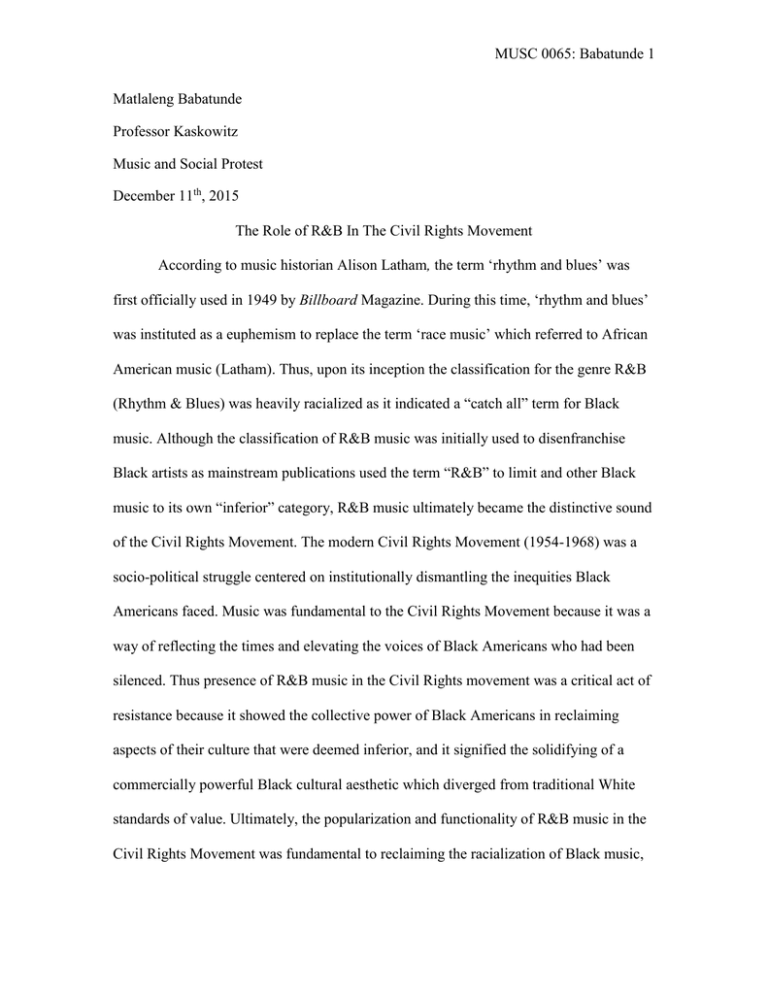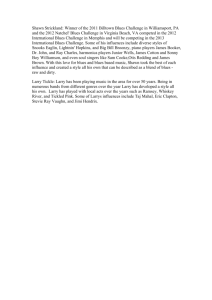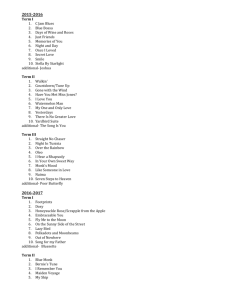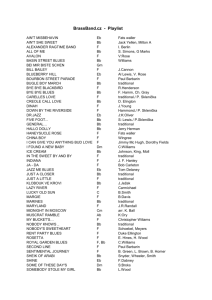
MUSC 0065: Babatunde 1
Matlaleng Babatunde
Professor Kaskowitz
Music and Social Protest
December 11th, 2015
The Role of R&B In The Civil Rights Movement
According to music historian Alison Latham, the term ‘rhythm and blues’ was
first officially used in 1949 by Billboard Magazine. During this time, ‘rhythm and blues’
was instituted as a euphemism to replace the term ‘race music’ which referred to African
American music (Latham). Thus, upon its inception the classification for the genre R&B
(Rhythm & Blues) was heavily racialized as it indicated a “catch all” term for Black
music. Although the classification of R&B music was initially used to disenfranchise
Black artists as mainstream publications used the term “R&B” to limit and other Black
music to its own “inferior” category, R&B music ultimately became the distinctive sound
of the Civil Rights Movement. The modern Civil Rights Movement (1954-1968) was a
socio-political struggle centered on institutionally dismantling the inequities Black
Americans faced. Music was fundamental to the Civil Rights Movement because it was a
way of reflecting the times and elevating the voices of Black Americans who had been
silenced. Thus presence of R&B music in the Civil Rights movement was a critical act of
resistance because it showed the collective power of Black Americans in reclaiming
aspects of their culture that were deemed inferior, and it signified the solidifying of a
commercially powerful Black cultural aesthetic which diverged from traditional White
standards of value. Ultimately, the popularization and functionality of R&B music in the
Civil Rights Movement was fundamental to reclaiming the racialization of Black music,
MUSC 0065: Babatunde 2
integrating resistance into the Black cultural aesthetic and challenging traditional
mainstream definitions of protest music.
According to historiographer Paul S Boyer, the full United States Civil Rights
Movement includes around three centuries of resistance of racial inequities (Boyer). The
different phases to this expansive struggle can be divided into four sections:
Revolutionary War to Civil War (1775-1865), the Reconstruction era through World War
II (1865-1945), and post World War Two onwards (Boyer), However, for the purpose of
this paper when the term “Civil Rights Movement” is used, it will be in reference to the
relatively modern day Civil Rights Movement which is often recognized as starting
around 1954, with the Brown V. Board of Education decision to desegregate public
schooling, and ending in 1968 with the assassination of Dr.Martin Luther King and the
shift towards a more Black radical approach to liberation (Boyer).
The Civil Rights Movement (1954-1968) put an emphasis on using institutional
structures, like the Supreme Court, as vehicles for creating systematic change. This was
reminiscent of the radical change that occurred within the Reconstruction Movement
(1865- 1877) in which, Black men utilized political advocacy by voting, or attempting to
vote, and even holding positions in legislation (Gates). From 1877 onwards Black
Americans were forced to give up their small glimpse of political advocacy through
terrorism by various white supremacist groups and structures, including the Klu Klux
Klan. Thus, when the 1954 Brown V. Education decision to desegregate public schools
was passed and Thurgood Marshall, the first Black Supreme Court Justice, was seen as
the advocate of this decision, hope that Black Americans could become full American
citizens was reignited.
MUSC 0065: Babatunde 3
It is mportant to consider the historical role of religion in the Civil Rights
Movement seeing as many of the leaders of the Civil Rights Movement used Churches
and Mosques as spaces for organizing Black resistance. However, one of the main
differences in Black religious identity was firstly, the Black Muslim Movement led by
Elijah Muhammad and Malcolm X was based in Black radical theory of liberation, selfdefense, and secondly, that the extensive acculturation of Christianity into Black
American culture meant that the Black Church had unique ties to Black music which
shaped the R&B music of the Civil Rights Movement.
Since the categorization “R&B” was used in many spaces as a general term for
Black music, there is a diverse range in songs that fit under the genre. Nevertheless, much
of the music that was being distributed as R&B shared a common thread of musical
influences rooted in historical African American music. The primary musical influences
in R&B are rural blues, jazz, and gospel (Finkleman).
Rural blues was mainly used in Texas, Georgia, and the Mississippi Delta and has
been characterized by its distinctive acoustic guitar sound paired with influences from
traditional hollersongs that were used to motivate work in the forced labor of African
Americans (Finkleman). Similarly, according to Phillip’s World Encyclopedia, Jazz is a
genre that was born out of African American folk music and, “is traditionally
characterized by improvisation, steady rhythm, and prominence of melody, often with
elements derived from the blues” (“Phillip’s World Encyclopedia”). Lastly, Gospel music
arose from the forcing of Christianity on enslaved Africans. It is a mixture of Protestant
hymns and African rhythm and melodies. The mostly joyful nature of Gospel songs
MUSC 0065: Babatunde 4
embodies the revivalist Christian meaning of gospel as “good news” (Phillip’s World
Encyclopedia”).
In Just My Soul Responding: Rhythm and Blues, Black Consciousness, and Race
Relations, scholar Brian Ward illustrates the agency of Black youth in shaping and
popularizing R&B. Ward explains that in the mid 20th century “an increasingly
urbanized, increasingly non-Southern Black audience…began to reject the gritty, rural,
down-home sounds of the old blues” (Ward 40). Black youth used R&B as a way to
construct and self-determine an alternate reality that wasn’t so consumed by the day to
day horrors and intergenerational melancholy imposed upon Black Americans. This is
illustrated through writer Woodie King’s interpretation of R&B:
When we added rhythm to our blues, we did it so that our existence would
be less of a burden than could be detected by the casual observer… And
our blues singers kept telling us in no uncertain terms that we were blue…
But we did not have to deal with those things if we could create an
alternate. The rhythm became an alternate. – Woodie King ( Ward 56)
However, as Tennessean Isaac Hayes recounts, some of the youth’s resistance to
traditional blues music was rooted in internalized anti-Blackness. Hayes said, “As a kid
in the fifties, I was taught to be ashamed of the blues. We thought of it as plantation
darkie stuff. And that was miles from where we wanted to be” (Ward 56). This
internalized anti Black aversion to blues relates back to the anti Black way mainstream
music outlets used “R&B” and denounced Black music.
Although it is imperative for one to recognize Black youth’s role and agency in
shaping the “R&B” genre, it is also important to acknowledge the ways R&B was used
MUSC 0065: Babatunde 5
to limit and disenfranchise Black artists. Mainstream publications, and radio stations that
dominated the music industry used the term “R&B” to bar Black music into its own
separate category which allowed for the continual plagiarism of Black music. This is
exemplified through hits like The Beach Boys “Surfin’ USA”, Elvis Presley’s “Hound
Dog”, and the Beatles “Come Together” which were all stolen from Black artists who
were placed in the R &B category like Chuck Berry and Willie Mae Thorton (Ward 270).
Therefore, central to the survival of R&B has been resistance to anti Black tactics, which
seeks to starve Black artists, and a conscious reclaiming of Blues and other aspects of
Black music, which were deemed inferior. These aspects aided heavily in positioning
R&B as an appropriate genre to accompany the Civil Rights Movement.
Some prominent archetypes of popular R&B Civil Rights songs are “A Change is
Gonna Come” by Sam Cooke, “Mississippi Goddamn” by Nina Simone, and “People Get
Ready” by the Impressions. Sam Cooke, The Impressions and Nina Simone all played
active roles in the Civil Rights Movement, but in different ways. Sam Cooke was an
R&B singer who was popular with Black and White audiences. When he rose to fame in
the early 60s, much of his music was not overtly political ( Ward 289). However, Cooke
changed this with the release of his soulful song in 1964, “A Change Is Gonna Come”.
This song was especially powerful in its soul influences and lyrics which overtly
commented on the daily indignities of Jim Crow segregation like, “I go to the movies,/ I
go downtown./ Someone keeps telling me,/ not to hang around” (Cooke). However,
Cooke’s R&B Civil Rights classic seemed to juxtapose his personal commitment to the
Movement. Apart from allegedly desegregating his concert with Jackie Wilson in 1959 at
the Norfolk Arena, there aren’t many records of Cooke actively involved in protests, or
MUSC 0065: Babatunde 6
even donating to major Civil Rights Organizations (Ward 290). “A Change Is Gonna
Come” illustrated Cooke’s commercial commitment to The Movement and gave him the
social credibility that many R&B artists were encouraged to prove. The expectation of
the critically conscious Black R&B artist is expanded on through the following excerpt:
By the late 1960s it was more than any self-respecting soul sister or
brother could afford in terms of conscience, credibility or commerce not to
be pledging very public allegiance to the struggle, doing benefit concerts,
donating to worthy black causes, and often boldly speaking or singing out
against racism in the entertainment industry and society at large, there has
been an assumption that Rhythm and Blues artists and entrepreneurs had
always been so forthright, committed and engaged; that they had always
given generously of their prestige, income, time and talent to the
Movement. (Ward 289)
Nina Simone is an example of an R&B artist who was as invested in the
Movement in her personal life as her musical persona was. In her social life, she was
known to surround herself with Black intellectuals and activists such as Lorraine
Hansberry, James Baldwin, Miriam Makeba, Kwame Ture, and Langston Hughes
(Tsuruta 54). However, her introduction to protest music was one of pain and sorrow. In
1963, after hearing about a church bombing that killed four Black girls in Birmingham
Mississippi, Nina Simone wrote one of her most memorable protest songs “Mississippi
Goddam” (Feldstein 1). “Mississippi Goddam”, and Nina Simone’s protest music as a
whole, stood out against other R&B artists protest music because it promoted radical
ideas which prioritized Black autonomy and self-governance before integration. An
MUSC 0065: Babatunde 7
example of this is the following lines from “Mississippi Goddam”, “ Me and my people
are just about due/… All I want is equality/For my sister, my brother, my people, and me/
Yes, you lied to me all these years” (Simone).
The instrumentation of “Mississippi Goddam” stayed true to Simone’s “ eclectic
repertoire that blended jazz with blues, gospel, and classical music” (Feldstein 1). The
individuality of Simone’s songs and sound meant that her protest music was not
necessarily chanted by large crowds at protest. Nevertheless, her unique Rhythm and
Blues sound specifically used in songs like “Mississippi Goddam” was still protest music,
because it fueled everyday people to believe in collective power and go out to protest in
attempt to make change. This directly contradicts many mainstream definitions, which
cite protest music as music that “needs a cause to serve as fuel; and it needs to be music
sung or performed by protestors, not at them” (Miyakawa).
The Impressions was a three piece group which around the 1960s became known
for producing “positive, uplifting rallying cries throughout the 1960s… (They) celebrated
black pride and offered unmistakable endorsements and encouragement for those
involved in the black struggle” (Ward 301). In the lyrics of “People Get Ready”
songwriter and singer, Curtis Mayfield drew power from alluding to gospel imagery by
using the Exodus motif to illustrate the imagined community of Black people nationally
leaving behind the subjugation and oppression of the US and creating their own home
(Ward 302). This is especially evident in the following verse: “People get ready/for the
train to Jordan,/picking up passengers/coast to coast/Faith is the key/open the doors/unbar
them” (Mayfield). “People Get Ready” is a manifestation of the Gospel, soul influences
MUSC 0065: Babatunde 8
and notion of constructing new, livable realities that were central to the R&B genre
during the Civil Rights Movement.
Ultimately, the R&B genre was significant to the success of the Civil Rights
Movement because it illustrated how political resistance to oppressive systems did not
always mean the denouncement of those systems, but the reclamation and creation of
ones own system. Central to Rhythm and Blues was the agency of Black youth in
constructing new realities, through song, where they could feel empowered enough to
enact change in their own lives. Eventually, the Civil Rights Movement and Black
consciousness became so ingrained in R&B that Black popular artists like Sam Cooke
were expected to fulfill their audiences’ need for politically aware Black artists to look up
to. Additionally, artists like Nina Simone and the Impressions defied the narrow
definition of protest music having to be applicable for use in organized protests, by
creating songs that became the spark that encouraged their audience to enact change.
Thus, through the use of Black protest music in the Civil Rights Movement, Black
America was able to transform the label “R&B” from its use in mainstream publications
as a inferiorized subgroup for Black art, into a genre that was pivotal to integrating the
resistance of the Civil Rights Movement into the Black cultural aesthetic.
MUSC 0065: Babatunde 9
Works Cited
The African Americans Many Rivers To Cross. Dir. Henry Louis Gates. Perf. Henry
Louis Gates Jr. PBS, n.d. Netflix.
Boyer, H. "Civil Rights Movement." Oxford Companion to US History. Oxford: Oxford
UP, 2004. Web.
Cooke, Sam. A Change Is Gonna Come. 1964. CD.
Feldstein, Ruth. ""I Don't Trust You Anymore": Nina Simone, Culture, and Black
Activism in the 1960s." The Journal of American History 91.4 (2005): 1349-379.
JSTOR. Web. 11 Dec. 2015.
Finkleman, Paul, ed. "Rhythm and Blues." African American History 1896 - Present.
2009. Oxford Reference Online [Oxford UP]. Web.
Garofalo, Reebee. Rockin' Out: Popular Music in the USA. Upper Saddle River, NJ:
Pearson/Prentice Hall, 2011. Print.
Goosman, Stuart L. Group Harmony: The Black Urban Roots of Rhythm & Blues.
Philadelphia: U of Pennsylvania, 2005. Print.
Latham, Alison. "Rhythm and Blues." Oxford Reference. Oxford University Press, 2009.
Web.
Mayfield, Curtis. People Get Ready. The Impressions. Rec. 1960. 1960. CD.
Miyakawa, Felicia. "“I Can’t Breathe”: Protest Music Now." The Avid Listener. The Avid
Listener, n.d. Web. 11 Dec. 2015.
Simone, Nina. Mississippi Goddam. 1963. CD.
Ward, Brian. Just My Soul Responding: Rhythm and Blues, Black Consciousness, and
Race Relations. Berkeley: U of California, 1998. Print.






